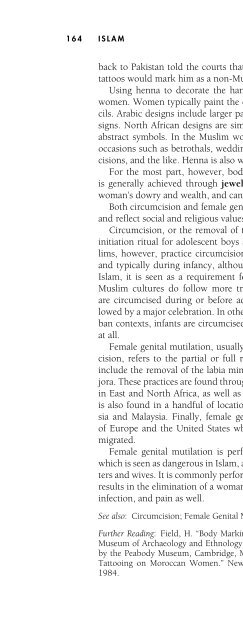Encylopedia of Body Adornment.pdf - Print My Tattoo
Encylopedia of Body Adornment.pdf - Print My Tattoo
Encylopedia of Body Adornment.pdf - Print My Tattoo
You also want an ePaper? Increase the reach of your titles
YUMPU automatically turns print PDFs into web optimized ePapers that Google loves.
164 ISLAM<br />
back to Pakistan told the courts that since he was a convert to Christianity, his<br />
tattoos would mark him as a non-Muslim, which could put his life in danger.<br />
Using henna to decorate the hands and feet is very popular among Muslim<br />
women. Women typically paint the designs on freehand or use inexpensive stencils.<br />
Arabic designs include larger patterns and are more abstract than Indian designs.<br />
North African designs are simple and include geometric shapes as well as<br />
abstract symbols. In the Muslim world, henna is mostly associated with special<br />
occasions such as betrothals, weddings, childbirths, naming ceremonies, circumcisions,<br />
and the like. Henna is also worn to celebrate the end <strong>of</strong> Ramadan.<br />
For the most part, however, body adornment in much <strong>of</strong> the Muslim world<br />
is generally achieved through jewelry, which can be decorative, can serve as a<br />
woman’s dowry and wealth, and can serve as amulets to ward <strong>of</strong>f evil.<br />
Both circumcision and female genital mutilation are also associated with Islam,<br />
and reflect social and religious values.<br />
Circumcision, or the removal <strong>of</strong> the foreskin <strong>of</strong> the penis, is performed as an<br />
initiation ritual for adolescent boys around the world, and predates Islam. Muslims,<br />
however, practice circumcision as well, although not as an intiation ritual<br />
and typically during infancy, although sometimes later. While not mandated by<br />
Islam, it is seen as a requirement for marriage and for Muslim converts. Some<br />
Muslim cultures do follow more traditional tribal practices, in that their boys<br />
are circumcised during or before adolescence as part <strong>of</strong> a rite <strong>of</strong> passage, followed<br />
by a major celebration. In other Muslim societies, however, especially in urban<br />
contexts, infants are circumcised in the hospital with no celebration or ritual<br />
at all.<br />
Female genital mutilation, usually known by its proponents as female circumcision,<br />
refers to the partial or full removal <strong>of</strong> the clitoris, and may or may not<br />
include the removal <strong>of</strong> the labia minora and the sewing together <strong>of</strong> the labia majora.<br />
These practices are found throughout the Muslim world. It is most prominent<br />
in East and North Africa, as well as in some parts <strong>of</strong> the Arabian peninsula, and<br />
is also found in a handful <strong>of</strong> locations in the Middle East, as well as in Indonesia<br />
and Malaysia. Finally, female genital mutilation is now being seen in parts<br />
<strong>of</strong> Europe and the United States where Muslims from these countries have immigrated.<br />
Female genital mutilation is performed in order to control female sexuality,<br />
which is seen as dangerous in Islam, and to ensure the purity and fidelity <strong>of</strong> daughters<br />
and wives. It is commonly performed on girls between the ages <strong>of</strong> 4 and 8, and<br />
results in the elimination <strong>of</strong> a woman’s sexual pleasure, and for many, in scarring,<br />
infection, and pain as well.<br />
See also: Circumcision; Female Genital Mutilation; Henna<br />
Further Reading: Field, H. “<strong>Body</strong> Marking in Southwestern Asia,” Papers <strong>of</strong> the Peabody<br />
Museum <strong>of</strong> Archaeology and Ethnology, Harvard University, Vol. XLV, No. 1, published<br />
by the Peabody Museum, Cambridge, MA, 1958; Searight, S. “The Use and Function <strong>of</strong><br />
<strong>Tattoo</strong>ing on Moroccan Women.” New Haven, CT: Human Relations Area Files, Inc.,<br />
1984.



